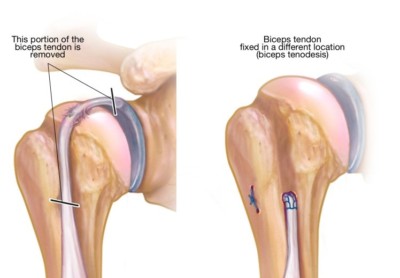The Painful Clicking, Popping and Catching Shoulder
Many patients ask me about pain from a “clicking, popping, catching/snapping” shoulder issue when they see me in the office. Usually, I am able to answer their questions after listening to the descriptions of when they experience the discomfort associated with this phenomenon and performing a thorough physical exam on their shoulder. While there are several potential reasons why a shoulder might click, by far, the most common reason is not one most patients (or physicians) really appreciate or correctly identify. We’ll get to that later.
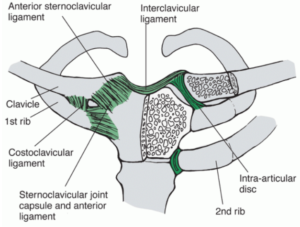
Intra-articular Disc
Overall, the most common reasons why people experience painful “clicking, popping, catching/snapping” in their shoulder are related to:
- AC joint arthritis or a tear of the intra-articular disc (see picture)
- Shoulder instability where the ball of the ball-and-socket joint dislocates or subluxes (meaning partially dislocates), (see picture)
- Biceps dislocations or instability
By far, the most common reason why people experience painful “clicking, popping, catching/snapping” in their
shoulder with movement is biceps instability.
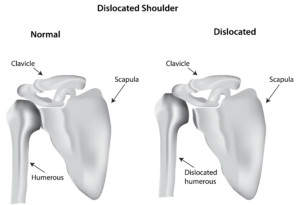
Dislocated Shoulder
It’s Not What You Think
When I bring-up biceps problems to most people, they think of the biceps-curl, the gym exercise that we are all familiar with doing. Surprising to many of my patients, I almost never mean that they will have pain doing a biceps curl when I am discussing biceps problems with them.
Rather, the problems with the biceps that I manage for my patients every day revolve around the tendon, not the muscle (see picture) of the biceps.
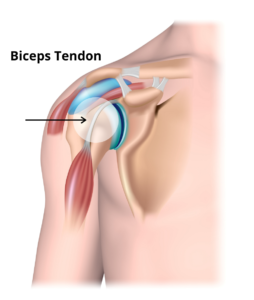
Biceps Tendon
From my perspective as a shoulder expert, and I deal with biceps problems all the time, biceps instability is by far, the most common disorder of the shoulder that I treat.
In these patients, the pain occurs around what most people associate with the deltoid, or even triceps, muscles. Biceps instability causes a pain when someone is rotating their shoulder – not curling a dumbbell. Activities that generate biceps pain include things like reaching in the back seat of a car, putting on a coat, throwing a ball (on release), pulling a seat belt across one’s body or taking-off/putting-on one’s bra. Once the pain from these daily activities becomes regular or intense, it becomes difficult to ignore.
So, what is happening to the biceps?
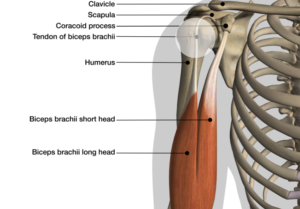
Bicipital Groove
The most common reason for this painful “clicking, popping, catching/snapping” in the shoulder due to the biceps tendon is the result of the biceps subluxing or dislocating out of the groove that it is designed to occupy (see picture). This is called biceps instability: the result of a loose/torn soft-tissue mechanism, the biceps pulley or rotator interval. This pulley can be torn in a traumatic event such as a dog pulling a leash and jerking the arm suddenly or can loosen gradually as one ages or does repetitive activities over time, for example a competitive swimmer.
What can you do to help this problem?
One of the most powerful interventions in treating biceps instability is the ultrasound guided corticosteroid injection. It is extremely important, in my experience, to have this injection performed by someone who is very skilled at ultrasound guided injections (I do >3000/year).
At this point, I know you are dying to ask me how a “shot” can stop the biceps from dislocating? It cannot. However, if the injection is administered properly, the best case scenario is that you can convert this painful clicking shoulder into a painless clicking shoulder for a “significant amount of time” without surgery. What is a significant amount of time? I always make my patients judge…but, from experience, it usually means at least 6-8 months of pain free range-of-motion and sometimes a great deal longer!
Ultimately, if the shots do not provide lasting relief, which can sometimes be the reality, then a surgical repair may be necessary. This is especially the case in patients with very unstable biceps or who do a lot of repetitive activities (serving tennis balls). Repairing the biceps instability surgically is the right choice for some patients in order to restore them to their athletic passion or restore their quality of movement.
How difficult is surgery for this procedure?
The repair for an unstable biceps is called a biceps tenodesis. The purpose of this surgery is to “fix” the biceps to the humerus arm bone (see picture). The surgery is an outpatient arthroscopic surgery that typically takes me 5-7 minutes to perform. The recovery enables patients to use their arms out of the sling within 3 days and home therapy starts on day 3 after surgery. By 4-6 weeks, I expect patients to be able to raise their arms almost fully and to start progressive strengthening exercises in 3 months.
Learn more about this procedure and its recovery here.

